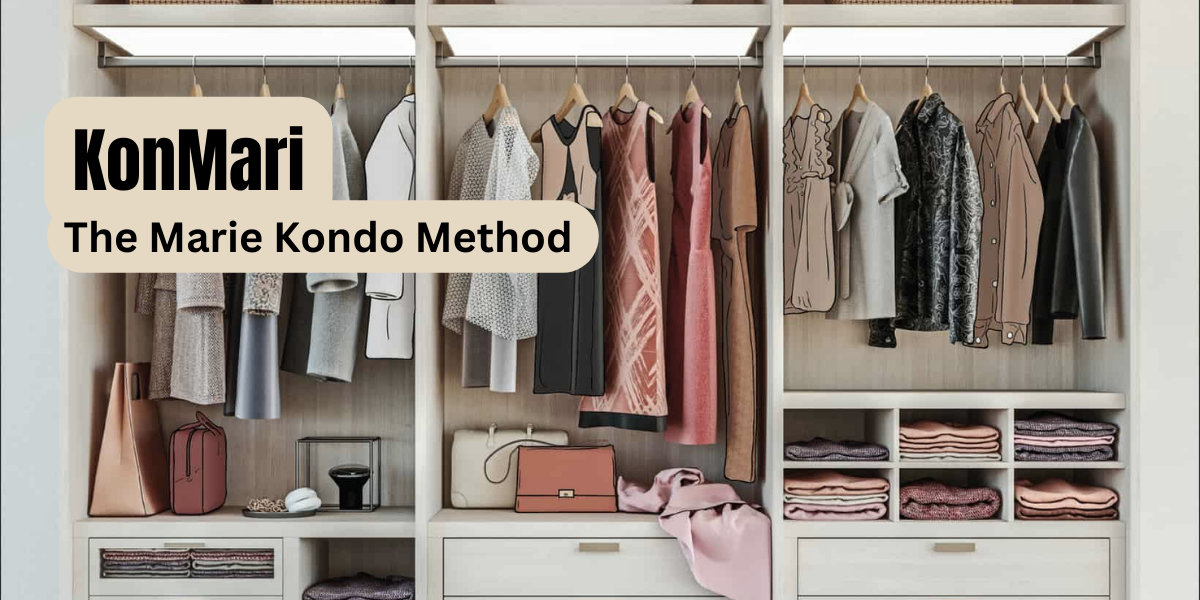The Japanese guru’s ground-breaking KonMari approach has made the organization trendy. People have learned to discard anything that does not spark joy and to fold things vertically as a result of the Marie Kondo method. Let’s explore it and learn more about it.
What Is the KonMari Method?
The KonMari Method is Marie Kondo’s minimalistic method for organizing your belongings that advocates organizing and decluttering by category instead of by location.
It is a revolutionary method of cleaning your house. The KonMari Method starts with getting rid of the physical things that don’t make you happy so you may surround yourself with just the things that do.
The process of “tidying up” can be summed up in two simple steps:
- Choosing what to preserve and what to throw away
- Choosing a location for the stuff you want to keep
Who Is Marie Kondo?
Marie Kondo is a Japanese organization expert. She has written many best-selling organizational books, facilitates conferences using her KonMari Method, and currently stars in the Netflix original series Tidying Up With Marie Kondo.
Marie’s journey towards tidying is chronicled in The Life-Changing Magic of Tidying Up. Marie describes how, as a young child, she developed an obsession with organizing and straightening up. She would spend hours in her room experimenting with various arranging methods. Some had a greater impact than others. It also outlines the fundamental ideas behind her organizing technique.
An Overview of the KonMari Method
Although many people may think her method is only based on tidying, it truly focuses on getting rid of things that aren’t useful. Kondo instructs you to start by taking everything out of your drawers, clearing your closet, all the books and papers from your shelves, everything on your desk or workspace, and so on, to decide what qualifies.
When you have a pile of each category, go over each item and ask yourself if it sparks joy, and discard items that don’t. Kondo says that this may initially feel uncomfortable or out of the ordinary, but she promises readers and viewers that as you go, you’ll get more adept at identifying sentimental items. You should have a considerably smaller collection of stuff left after getting rid of everything in each category, which you can then put back in various cupboards, drawers, shelves, and boxes.
Let’s dig deeper into the practices described in her book.
Don’t Skip Any Step
You, the reader, are expected to adhere to Marie Kondo’s philosophy since she preaches that there is only one path to success with it. If you want to live the magic of tidying, she recommends not skipping steps or choosing not to adhere to some of her plan’s instructions.
Visualize Your Goals
Marie Kondo suggests that you spend some time visualizing the interior of your home. How could you enhance your environment to improve your mood and energy? To visualize what it would be like to live in a space devoid of clutter, think in tangible terms. You need to be very specific while visualizing and manifesting the house of your dreams.
Checklist
Marie Kondo provides a “tidy by category” checklist. You will begin by organizing your clothes and working your way through the more sentimental objects based on them. You can improve your ability to discard extra things you don’t need by going step by step through that checklist.
Do Not Take Too Long
Most of the other information you have read about minimalism on social media should probably be forgotten if you are considering beginning to declutter using the KonMari Method. There is a lot of poor information about decluttering available. Some suggest taking on a whole month’s non-stop commitment, and some advise disposing of one item every day.
These techniques are absurd. You should turn each day of decluttering into a memorable occasion, and the entire process shouldn’t take more than six months. As your life becomes more liberated from things, you should experience excitement and delight. While there is no set deadline for the KonMari Method, the author does expect you to go quickly.
Kon Mari’s Folding Method
Based on origami-inspired techniques, Kondo developed a distinctive method of clothing folding that has completely changed numerous wardrobes. Some people refer to Marie’s approach as “file folding clothes,” but she sees it as much more than that. Instead of stacking them or, worse, piling them in a chair, fold your clothes neatly and set them up vertically to avoid creases and save space. This will also help you to show your appreciation for each item that brings you joy. The outcomes are revolutionary.
What About Your Closet?
Now that you don’t only keep the items you need in your closet, it will serve a far more significant role. You’ll have everything you need in your closet, as well as treasured items that have nowhere else to go. Even if they seem unnecessary, Marie suggests that it is important to keep the things that you cherish. As a result, fill your closet with gorgeous souvenirs that make you feel warm and fuzzy inside.
Avoid Focusing On What to Discard
If you focus only on throwing things away, you won’t be doing it the Marie Kondo way. Concentrate on what must be kept, and the rest will be eliminated automatically. Why? Because what usually happens when you centralize on what to throw away is that you feel guilty, nostalgic, and fearful that you might need the items later. Humans are hesitant to part with their belongings by nature.
Consider its genuine function in your life when you come upon something you can’t bear to part with. How many of the objects you own have already served their intended purpose may surprise you. You will be able to genuinely organize your possessions and your life by appreciating their contribution and parting ways with them in thankfulness.
Let Your Feelings Guide You
Concentrate your efforts on recognizing and surrounding yourself with the things that make you happy. Nobody else can tell if something is truly valuable to you or not.
If you bought a book that, for some reason, you haven’t been able to read, it means that it already fulfilled its purpose in your life or that you were not meant to read it. It is a sign to let it go.
Your Bag/Purse
Instead of carrying around a wallet, bag, or pocketbook that is constantly cluttered with candy wrappers, crumbs, and invoice tickets, picture having one that is always clean. The KonMari Method provides guidelines for how to handle the bags you use every day. It is recommended to empty the bag and put everything back where it belongs once you are done using it so you won’t need to carry around a lot of stuff all the time.
Papers
Marie suggests throwing away almost all the paperwork! That includes online instruction manuals, old receipts, and scratch paper. Of course, there are some essentials that you must retain. Make electronic copies if necessary, but trash the stacks of useless paper that clutter your drawers. What you have left should be split into two piles: social security cards, birth certificates, and other paperwork that requires action. You will divide these heaps into two files. There will be no more paper than what can fit in those two folders!
Be Grateful
The appreciation and emotional connection that Marie Kondo believes we should have with our belongings, and especially with our house as a whole, distinguishes the Konmari technique from a regular minimalistic approach. According to her, being connected to the sentiments you have towards the goods you own, and showing thanks to the things you choose to remove, is a huge component of the jigsaw that is having an orderly and clean life.
Don’t Get Your Family Involved
It is considerate to keep your post-declutter pile out of sight. Seeing stuff you are dumping can be highly upsetting for loved ones.
When parents observe what their children are independently deciding to trash, they can stress.
Despite understanding that they should celebrate their maturity and sense of discipline and organization, parents often find it upsetting to see toys, clothes, and memories from their child’s past in the trash, especially if they were gifts from them.
Identify Items that Spark Joy
This part of the KonMari Method is quite beneficial. Being in sync with the magic that is going on around you will allow you to feel the incredible sparks of delight that flare when you hold something you genuinely love.
The core principle of the KonMari Method is that each thing in your home possesses a mind or energy. Marie Kondo believes that objects in your house feel sad when hidden away and full of dust and happy when constantly used.
FAQs
What If I Get Stuck?
We advise you to return to the basics when you have lost interest or are apprehensive about going on to the next step. Consider how beautiful the finished thing will be and how lovely it will be to live in a well-organized place. If your imagination betrays you, you can read the book again. That will surely give you the push you need to keep going.
Can I Hire Someone to Do the KonMari method In My House?
Kondo used to do it herself, but she is not available for hiring anymore since she is too busy developing an organizing empire. You may, however, hire one of her 200+ experts to clean and organize your property. Certification levels range from green to master for all consultants. Rates vary according to a consultant’s level of expertise.
Is the KonMari Method Effective for Everyone?
The KonMari method is demanding and requires dedication, time, and energy to finish. It may not be effective for people who don’t have the time or will to commit to it, but for those who seek perfectly organized and forever clutter-free houses, it has been demonstrated to be highly effective.
The Wrap-Up
The concept of completely cleaning and decluttering your house may seem daunting, but making time to discard what you are not using anymore is worthwhile. You will feel better, your worry will subside, and your mind will be stress-free once you begin your “house detox” with the Marie Kondo method. Developing new habits takes work, but you can do it!





